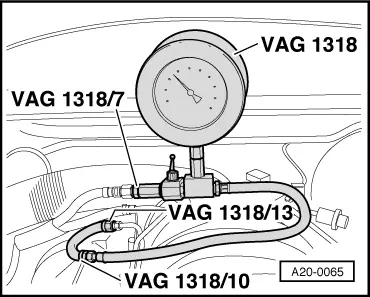-
‒ → Connect pressure gauge V.A.G 1318 between fuel supply pipe and fuel rail using adapters 1318/7, 1318/10 and 1318/13. Lever on pressure gauge must be in the "open" position (lever aligned with direction of flow).
-
‒ Disconnect vacuum hose between fuel pressure regulator and intake manifold at fuel pressure regulator end; seal off end of hose.
Notes:
-
◆ If fuel leaks out at the connection for the fuel pressure regulator during the following test, fit a new fuel pressure regulator.
-
◆ During the following test, do not allow the engine to run any longer than necessary with the vacuum hose disconnected. When the hose is disconnected, the increased fuel pressure causes enrichment of the air/fuel mixture which may exceed the Lambda control regulation limit and be registered as a fault in the fault memory.
-
‒ Start the engine and run at idling speed.
-
‒ Switch off the air conditioner.
-
‒ Measure fuel pressure.
-
‒ Specification: approx. 3.8 ... 4.2 bar
-
‒ If fuel pressure does not match specification, fit a new fuel pressure regulator for test purposes and repeat pressure test.
-
‒ If fuel pressure still does not match specification, check fuel pump and supply pipe for damage (e.g. pinching) and renew if necessary.
-
‒ If pressure is higher than specification, check return pipe for damage (e.g. pinching) and renew if necessary.
-
‒ Re-connect vacuum hose to fuel pressure regulator and observe drop in pressure on pressure gauge.
-
‒ When the vacuum hose is re-connected the fuel pressure should drop by around 0.5 bar.
- If the pressure does not change as specified, carry out the following tests:
-
‒ Check vacuum hose for cracks and other damage.
-
‒ Test vacuum hose for blockages at intake manifold.
To do this, disconnect hose at fuel pressure regulator and blow into it.
-
‒ If there are no leaks in the hose and no blockages at the vacuum connection, fit a new fuel pressure regulator.
Testing holding pressure
-
‒ Holding pressure 10 minutes after switching off engine (minimum pressure)
Specification:
- With engine cold: approx. 2.2 bar
- With engine hot: approx. 3.0 bar
If the specification is not attained:
Note:
A rise in pressure (due to fuel expansion) when the engine is hot is normal.
-
‒ Start the engine and run at idling speed.
-
‒ Switch ignition off after the pressure has built-up. At the same time close pressure gauge cut-off tap (lever at 90° to throughflow direction).
If the pressure does not drop, the following faults are possible:
-
◆ Union between pressure gauge and fuel supply pipe leaking
-
◆ Supply pipe leaking at fuel tank
-
◆ Return valve in fuel pump leaking
=> 6-cylinder engine (5-valve), Mechanics; Repair group 20; Removing and installing fuel delivery unit
If the pressure drops again, the following faults are possible:
-
◆ Fuel pressure regulator defective
-
◆ Injectors leaking
-
◆ Unions on pressure gauge downstream of cut-off valve leaking
Note:
When disconnecting the pressure gauge, close the cut-off valve, unscrew the union on adapter V.A.G 1318/12, then open the cut-off valve to drain off excess fuel into a suitable container.
|

